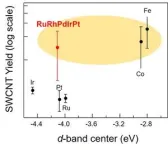Testing environmental water to monitor COVID-19 spread in unsheltered encampments
2024-04-03
(Press-News.org) To better understand COVID-19’s spread during the pandemic, public health officials expanded wastewater surveillance. These efforts track SARS-CoV-2 levels and health risks among most people, but they miss people who live without shelter, a population particularly vulnerable to severe infection. To fill this information gap, researchers reporting in ACS’ Environmental Science & Technology Letters tested flood-control waterways near unsheltered encampments, finding similar transmission patterns as in the broader community and identifying previously unseen viral mutations.
In recent years, testing untreated wastewater for SARS-CoV-2 incidence and dominant viral variants, as well as other pathogens, has been vital to helping public health officials determine infectious disease transmission in local communities. Yet, this monitoring only captures information on viruses shed from human feces and urine in buildings that are connected to local sewage infrastructure. Beyond the pandemic’s impact on human health, it also exacerbated socioeconomic difficulties and increased the number of people experiencing homelessness and living in open-air encampments without access to indoor bathrooms. To understand the prevalence of COVID-19 among people who live unsheltered, Edwin Oh and colleagues tested for SARS-CoV-2 in waterways near encampments outside Las Vegas from December 2021 through July 2022.
Using quantitative polymerase chain reaction, the researchers identified SARS-CoV-2 RNA in more than 25% of the samples tested from two flood-control channels. The highest detection frequency over the study period aligned with Las Vegas’ first wave of omicron variant infections, as confirmed through parallel testing at a local wastewater treatment plant. The researchers say these results suggest a similar level of transmission was occurring within the unsheltered community as it was among the general population. Then the researchers conducted whole genome sequencing to identify the SARS-CoV-2 variants in the waterways. These samples largely contained the same variants identified in the broader community. Deeper computational analysis of the viral sequences identified three novel viral spike protein mutations in some waterway samples, but the researchers have not yet examined what impact these mutations might have on viral function or clinical outcomes. Regardless, the ability to detect and identify SARS-CoV-2 in environmental water samples could help improve public health measures for a community that is often underrepresented in current surveillance methods. The researchers also say monitoring waterways could warn health officials of unexpected variants circulating in the community.
The authors acknowledge funding from the National Institutes of Health, the Nevada Governor’s Office of Economic Development, the Centers for Disease Control and Prevention, and the Water Resources Research Institute of the United States Geological Survey.
The paper’s abstract will be available on April 3 at 8 a.m. Eastern time here: http://pubs.acs.org/doi/abs/10.1021/acs.estlett.3c00938
###
The American Chemical Society (ACS) is a nonprofit organization chartered by the U.S. Congress. ACS’ mission is to advance the broader chemistry enterprise and its practitioners for the benefit of Earth and all its people. The Society is a global leader in promoting excellence in science education and providing access to chemistry-related information and research through its multiple research solutions, peer-reviewed journals, scientific conferences, eBooks and weekly news periodical Chemical & Engineering News. ACS journals are among the most cited, most trusted and most read within the scientific literature; however, ACS itself does not conduct chemical research. As a leader in scientific information solutions, its CAS division partners with global innovators to accelerate breakthroughs by curating, connecting and analyzing the world’s scientific knowledge. ACS’ main offices are in Washington, D.C., and Columbus, Ohio.
To automatically receive news releases from the American Chemical Society, contact newsroom@acs.org.
Note: ACS does not conduct research, but publishes and publicizes peer-reviewed scientific studies.
Follow us: X, formerly Twitter | Facebook | LinkedIn | Instagram
END
ELSE PRESS RELEASES FROM THIS DATE:
2024-04-03
As any surfer will tell you, waves pack a powerful punch. Now, we are one step closer to capturing the energy behind the ocean’s constant ebb and flow with an improved “blue energy” harvesting device. Researchers report in ACS Energy Letters that simply repositioning the electrode — from the center of a see-sawing liquid-filled tube to the end where the water crashes with the most force — dramatically increased the amount of wave energy that could be harvested.
The tube-shaped wave-energy harvesting device improved upon ...
2024-04-03
Choosing paint for your home brings a lot of options: What kind of paint, what type of finish and what color? Water-based paints have emerged as “greener” and less smelly than solvent-based options. And they are often advertised as containing little-to-no volatile organic compounds (VOCs). But, according to research published in ACS’ Environmental Science & Technology Letters, some of these paints do contain compounds that are considered VOCs, along with other chemicals of emerging concern.
Paint consists of four ingredients: pigments, binders, additives ...
2024-04-03
A fungus devastating frogs and toads on nearly every continent may have an Achilles heel. Scientists have discovered a virus that infects the fungus, and that could be engineered to save the amphibians.
The fungus, Batrachochytrium dendrobatidis or Bd, ravages the skin of frogs and toads, and eventually causes heart failure. To date it has contributed to the decline of over 500 amphibian species, and 90 possible extinctions including yellow-legged mountain frogs in the Sierras and the Panamanian golden frog.
A ...
2024-04-03
When we communicate with other people face-to-face, we do so by maintaining a certain physical distance from each other. This space surrounding our body while interacting is called the interpersonal space (IPS), and maintaining adequate IPS is crucial for better communication.
Many studies have investigated the psychological and physiological changes that occur based on the presence of another person in the IPS during face-to-face interactions. These studies are based on the avoidance behaviour that we experience when a stranger invades our IPS, which manifests in the form of increased heart rate and discomfort. However, ...
2024-04-03
California, a state known for its aggressive greenhouse gas reduction policies, is ironically the nation’s greatest emitter of one: sulfuryl fluoride.
As much as 17% of global emissions of this gas, a common pesticide for treating termites and other wood-infesting insects, stem from the United States. The majority of those emissions trace back to just a few counties in California, finds a new study led by Johns Hopkins University.
“When we finally mapped it out, the results were puzzling because the emissions were all coming from one place,” said co-author Scot ...
2024-04-03
Menlo Park, Calif. — After two decades of work, scientists and engineers at the Department of Energy's SLAC National Accelerator Laboratory and their collaborators are celebrating the completion of the Legacy Survey of Space and Time (LSST) Camera.
As the heart of the DOE- and National Science Foundation-funded Vera C. Rubin Observatory, the 3,200-megapixel camera will help researchers observe our universe in unprecedented detail. Over ten years, it will generate an enormous trove of data on the southern night sky that researchers will ...
2024-04-03
Scientists at the Institute of Pathophysiology of the University Medical Center Mainz made the first comprehensive analysis on how adults use tickling in connection with sexual activity. As part of their study, they surveyed 719 people with a so-called tickling fetish. The results of the study show that human sexuality encompasses a variety of forms of expression that need to be studied and understood in greater depth.
Most people laugh when they are tickled. But there are also individuals for whom tickling or being tickled triggers sexual arousal. This sexual preference is referred to as a tickle ...
2024-04-03
Research Highlights:
Asian American adults with more unfavorable factors related to income level, education, housing, access to health care and other social variables had a greater likelihood of having risk factors for cardiovascular disease in this study.
The relationship between social determinants of health and cardiovascular disease risk factors varied widely among some Asian American subgroups, based on the study’s findings.
Embargoed until 4 a.m. CT/5 a.m. ET Wed., April 3, 2024
DALLAS, April 3, 2024 — Having more unfavorable social determinants of health, such as being unemployed, uninsured or not having education beyond high school, ...
2024-04-03
Artificial Intelligence can be used to detect invasive Asian hornets and raise the alarm, new research shows.
University of Exeter researchers have developed VespAI, an automated system that attracts hornets to a monitoring station and captures standardised images using an overhead camera.
When an Asian hornet visits, VespAI can identify the species with almost perfect accuracy – allowing authorities to mount a rapid response.
Asian hornets (also known as yellow-legged hornets) have already invaded much of mainland Europe and parts of east Asia, and have recently been reported in the US states of Georgia and South Carolina.
The ...
2024-04-03
(Santa Barbara, Calif.) — A collaboration between research groups at the University of California, TU Dresden in Germany and Cedars-Sinai Guerin Children’s in Los Angeles has identified a mechanism by which embryonic cells organize themselves to send signals to surrounding cells, telling them where to go and what to do. While these signaling centers have been known to science for a while, how individual cells turn into organizers has been something of a mystery.
Until now. In a paper published in the journal Nature ...
LAST 30 PRESS RELEASES:
[Press-News.org] Testing environmental water to monitor COVID-19 spread in unsheltered encampments









